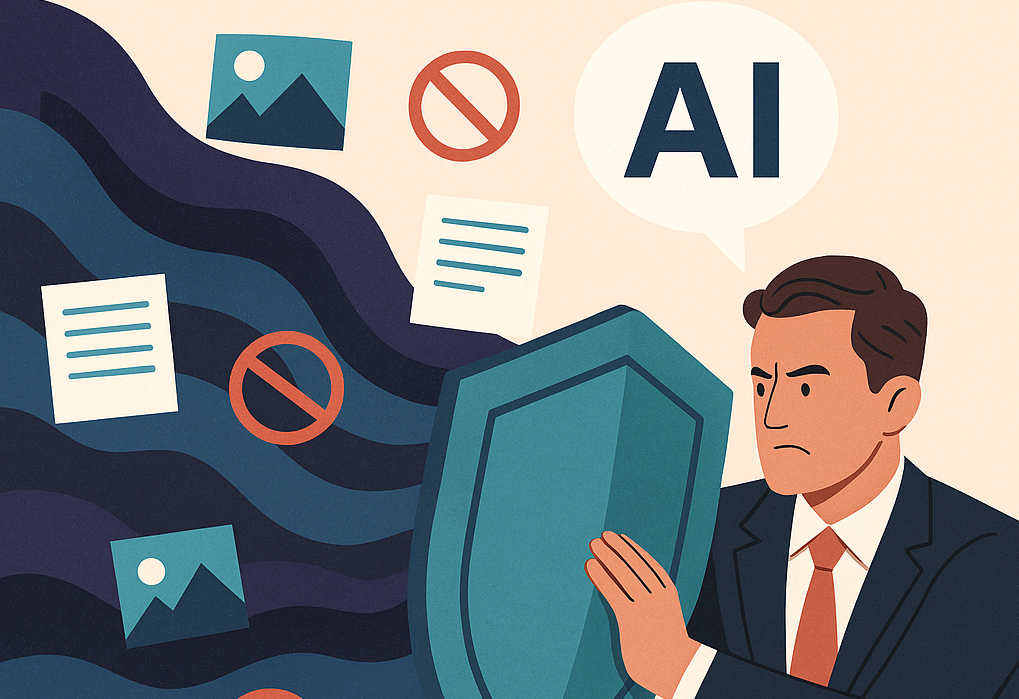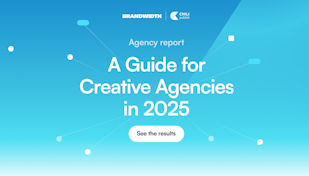AI is drowning your brand. Guardrails are the only lifeline

Generative AI was sold as the miracle cure for marketing’s chronic headaches. No more endless backlogs. No more waiting weeks for banner ads, translations, or social posts. Just type a prompt, and voilà — the machine delivers.
And yes, AI solved scarcity. But it also created something far worse: chaos.
Now every marketing team is sitting on an endless pile of assets — banners in 37 sizes, social posts in 12 languages, emails with 50 subject lines. Half of them are wrong, off-brand, or just plain weird. And no one knows which one to use.
It’s like we ordered a nice glass of wine and got an open fire hydrant instead. You can drink from it, sure, but you’ll choke before you get refreshed.
The problem isn’t speed. It’s control.
Ask any cmo right now what’s keeping them up at night. It isn’t “we don’t produce enough content.” It’s “we can’t control the content we already have.”
One brand I spoke with last month had 40,000 AI-generated assets sitting in their library. Forty thousand. And yet, when the campaign launched, half the markets used the wrong price, two used the wrong product shots, and one region ran an ad with imagery the brand had explicitly banned.
Mango learned this lesson the hard way when it used AI-generated models to show off clothes. The clothes looked fine. The models? Not so much. Customers spotted that the women weren’t real, trust took a hit, and suddenly the “time saved” looked like an expensive mistake.
And remember KFC Germany’s Kristallnacht push notification fiasco? That wasn’t AI, but it might as well have been. Automation without context is a grenade.
This is what AI gives us at scale: not just productivity, but exponential mistakes.
The operational traffic jam
Unlimited scale sounds sexy. Until you try to manage it.
Here’s how it plays out: AI creates 100 variations of a headline. Now someone has to test them, translate them, make sure they fit character limits, check disclaimers, and approve them. The bottleneck didn’t disappear. It just moved downstream and got bigger.
Instead of freeing people, AI has turned many creatives into traffic cops. They spend their days waving thousands of assets through endless checkpoints. Speed promised. Gridlock delivered.
And when everything is “personalized” or “localized,” it’s not unusual for a campaign to require hundreds of variants. Without structure, that becomes pure madness. A campaign that should take days drags into weeks. By the time it’s live, the moment’s gone.
Marrying creativity with control
The solution isn’t “less AI.” It’s AI with rails.
When I say guardrails, I don’t mean a 200-page brand book that collects dust on someone’s SharePoint. I mean rules that live inside the system, rules that are executable, rules that actually block bad content before it sees daylight.
Let’s break that down.
Creative guardrails
This is the obvious one. Fonts, colors, imagery, tone of voice. Do we allow stock photos? Do we allow sad imagery in a campaign about happiness? Does the product logo always sit top left, never bottom right? These are choices designers have agonized over for decades. With AI, those choices can’t just be guidelines — they have to be code.
Example: if AI tries to generate a banner with Comic Sans, it gets blocked automatically. Not reviewed, not “flagged.” Blocked. (Oh wait, AI doesn’t even have fonts — it just tries to fake them. Which somehow makes the idea of Comic Sans creeping back into our lives even scarier 😂).
Compliance guardrails
This is where it gets serious. Financial disclaimers, health warnings, trademark usage, language requirements. Humans often forget. AI doesn’t forget if you program it correctly.
Example: imagine AI generates an ad for a vitamin supplement and forgets the legal disclaimer. Without guardrails, that ad could go live. With guardrails, the system simply refuses to output the creative until the disclaimer is there. (Think of it as a stubborn lawyer coded into the workflow — the only lawyer you’ll ever love).
Operational guardrails
The boring but critical stuff: character limits, image ratios, file formats, deadlines. AI doesn’t care if Twitter only allows 280 characters — it’ll happily spit out 600. Guardrails care. They keep the campaign shippable.
Example: AI drafts a perfect Instagram caption — except it’s 1,200 characters too long. Guardrail trims or blocks it. The team doesn’t even waste time reviewing what would never ship. (If only guardrails worked on LinkedIn humblebrags too).
Here’s the thing: guardrails don’t limit creativity. They free it.
Think of designers as architects. They draw the blueprints, decide the structural rules, and then let builders construct a thousand variations of the same building safely. Nobody wants to live in a house where the plumber “got creative” with the foundation. Why do we accept that with marketing?
Guardrails also kill the stupid debates. No more five-hour meetings on whether the CTA button should be green or blue. If the rule is blue, it’s blue. End of story. Let’s argue about ideas instead.
And let’s not forget: guardrails save us from embarrassment. A few examples AI could produce without them:
- A Christmas ad with snowmen… launched in Australia, in July.
- A financial ad promising “guaranteed returns” (illegal in most markets).
- A product banner showing a price in Yen… for a European audience.
Guardrails stop all of that nonsense. They’re not a brake on creativity — they’re the steering wheel.
Creativity isn’t dead. but pixel-perfect thinking is.
Here’s the dirty truth: most customers don’t notice — or care — if your hero image is cropped 5 pixels tighter. They don’t buy more or less because the button was nudged 3 millimeters to the left.
But agencies do care. They’ve built an entire business model on pixel-perfect revisions and brand police work. They write the brand book, then charge you again to enforce it. It’s a brilliant racket. But it blocks innovation.
What matters isn’t micro-alignment. It’s macro-consistency: the right message, the right compliance, the right tone. And that’s exactly what AI, left to run wild, destroys.
Pixel-perfect? Please. The only people zooming in to 800% magnification are designers and — apparently — Adobe product managers who thought a loupe tool was a good idea. Customers? They’re scrolling past your ad in half a second while eating a sandwich.
The future: AI without guardrails will kill brands
Generative AI isn’t going away. By 2026, some predict over 90% of online content will be AI-generated. Whether that number is exact doesn’t matter. The direction is clear.
So the question isn’t “should we use AI?” You already are. The question is “will we control it?”
The brands who survive this shift will be the ones who build infrastructure, not just content. They’ll treat content like code — structured, validated, deployed at scale. They’ll empower AI but keep the guardrails human-defined.
The ones who don’t? They’ll drown in their own output. Their feeds will look like spam. Their ads will contradict each other. Their credibility will erode, one sloppy AI mistake at a time.
Closing: AI doesn’t kill creativity. AI without guardrails kills brands.
I’ve spent years in the trenches of marketing tech, and I can tell you this: the volume game is already over. Anyone can create content. The winners will be those who can control it.
Guardrails aren’t the death of creativity. They’re the only way to save it.
So the next time someone brags about how many ads their ai can pump out in an hour, ask them this: how many of those ads are safe, consistent, and on-brand?
CEO insights
Kevin Goeminne
Oct 1, 2025


